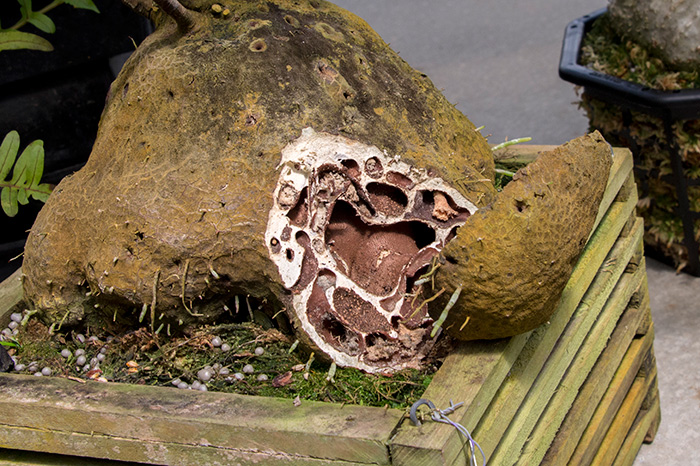The Huntington’s blog takes you behind the scenes for a scholarly view of the collections.
LOOK>> An Ant Plant
Posted on Mon., Nov. 9, 2015 by and
With LOOK>>, we venture into our wide-ranging collections and bring out a single object to explore in a short video. For this installment, we look at a Hydnophytum specimen, one of the ant plants in our tropical collections.
When you have seen one ant, one bird, one tree, you have not seen them all.
—E.O. Wilson, American biologist and ant specialist
Tropical forests teem with life, and ants are among their most populous creatures. Some ants have evolved together with specific plants to form mutually beneficial and fascinating relationships. These plants, which actually comprise a wide variety of botanically unrelated plants, are commonly referred to as ant plants.
The caudex (or swollen base) of the ant plant in the video may look like an overgrown potato, but it functions more like an apartment complex to its ant inhabitants. Selling points include protection from the elements, a range of rooms and hallways, controlled access, and, with time, add-on rooms. These homes are ideally situated on tree branches, where both the plant and the ants are safe from the many hazards of life in the forest.
The chambers and passages inside the plant’s succulent caudex serve a variety of purposes: ants use some rooms to cultivate edible fungus “farmed” on green morsels of vegetation brought inside for that purpose; ants use other spaces for waste products from their farming activities, and the nutrients that leach out provide some sustenance to the ant plant. In addition, the ants protect the plants from unwanted visitors, such as leaf-munching grasshoppers or fruit-gobbling birds, by streaming out of the caudex to see if they can add a little protein to their fungus diet.
 Cutaway view of the caudex of a different Hydnophytum specimen in The Huntington’s collections. Photo by Kate Lain.
Cutaway view of the caudex of a different Hydnophytum specimen in The Huntington’s collections. Photo by Kate Lain.Many types of ant plants—including the Hydnophytum specimen in the video—are excellent candidates for cultivation in warm, humid climates, including those found in greenhouses. The Huntington obtained its specimen from Atlanta Botanical Garden in 2001. This distinctive ant plant, with narrowly elliptic leaves and an uneven caudex surface, was introduced by Jerry Horne, a Florida nurseryman, in the 1980s, but its species has not yet been identified. (Unidentified plants of wild origin are not uncommon in cultivation, and it may take decades for their taxonomies to be resolved.)
When viewing the surprising chambers inside ant plants, people new to them often ask: “Where are the ants?” The Huntington’s ant plants house no ants; fortunately, these plants form their tuberous bases—handy for water storage as well as ant homes—whether they interact with ants or not. In fact, even the tiny seedlings of ant plants exhibit a caudex and form entrance holes and chambers as they grow, regardless of whether ants are present. So the more intriguing question may be this: can the ants survive without the plants?
Also in this series:
LOOK>> Spelling Slips (Aug. 1, 2016)
LOOK>> A Printed Fan (Dec. 3, 2015)
LOOK>> A Historiscope (Oct. 2, 2015)
LOOK>> A Myriorama (Sept. 1, 2015)
Dylan P. Hannon is curator of the Conservatory and tropical collections at The Huntington.
Kate Lain is the new media developer at The Huntington.